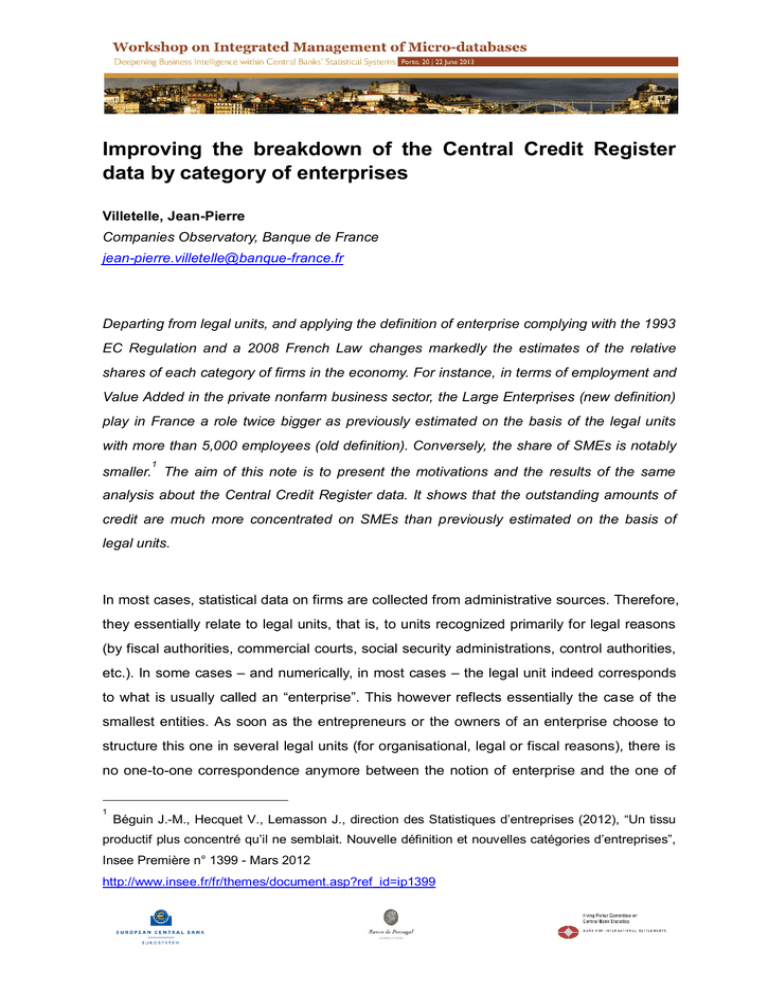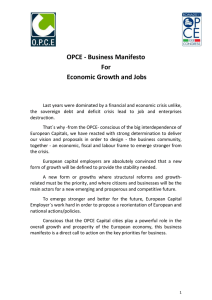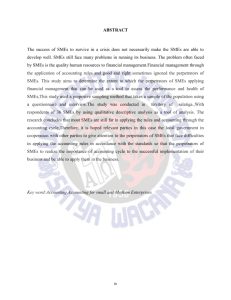Improving the breakdown of the ... data by category of enterprises
advertisement

Improving the breakdown of the Central Credit Register data by category of enterprises Villetelle, Jean-Pierre Companies Observatory, Banque de France jean-pierre.villetelle@banque-france.fr Departing from legal units, and applying the definition of enterprise complying with the 1993 EC Regulation and a 2008 French Law changes markedly the estimates of the relative shares of each category of firms in the economy. For instance, in terms of employment and Value Added in the private nonfarm business sector, the Large Enterprises (new definition) play in France a role twice bigger as previously estimated on the basis of the legal units with more than 5,000 employees (old definition). Conversely, the share of SMEs is notably 1 smaller. The aim of this note is to present the motivations and the results of the same analysis about the Central Credit Register data. It shows that the outstanding amounts of credit are much more concentrated on SMEs than previously estimated on the basis of legal units. In most cases, statistical data on firms are collected from administrative sources. Therefore, they essentially relate to legal units, that is, to units recognized primarily for legal reasons (by fiscal authorities, commercial courts, social security administrations, control authorities, etc.). In some cases – and numerically, in most cases – the legal unit indeed corresponds to what is usually called an “enterprise”. This however reflects essentially the case of the smallest entities. As soon as the entrepreneurs or the owners of an enterprise choose to structure this one in several legal units (for organisational, legal or fiscal reasons), there is no one-to-one correspondence anymore between the notion of enterprise and the one of 1 Béguin J.-M., Hecquet V., Lemasson J., direction des Statistiques d’entreprises (2012), “Un tissu productif plus concentré qu’il ne semblait. Nouvelle définition et nouvelles catégories d’entreprises”, Insee Première n° 1399 - Mars 2012 http://www.insee.fr/fr/themes/document.asp?ref_id=ip1399 legal unit. This is especially obvious if we take the case of holding companies which, by nature own other companies' shares and do not produce goods or services themselves. In this respect, the Council Regulation (EEC) No 696/93 of 15 March 1993 “on the statistical units for the observation and analysis of the production system in the Community” 2 stated that: “The enterprise is the smallest combination of legal units that is an organizational unit producing goods or services, which benefits from a certain degree of autonomy in decision-making, especially for the allocation of its current resources. An enterprise carries out one or more activities at one or more locations. An enterprise may be a sole legal unit.” (Section III.A) The explanatory note of the Council Regulation clarifies that: “The enterprise thus defined is an economic entity which can therefore, under certain circumstances, correspond to a grouping of several legal units. Some legal units, in fact, perform activities exclusively for other legal units and their existence can only be explained by administrative factors (e.g. tax reasons), without them being of any economic significance. A large proportion of the legal units with no persons employed also belongs to this category. In many cases, the activities of these legal units should be seen as ancillary activities of the parent legal unit they serve, to which they belong and to which they must be attached to form an enterprise used for economic analysis.” This definition did not spread much in practice, but in the case of France, a law passed in 2008 and its related Statistical Decree define now the practicalities for using this definition, 3 4 as long as the data for it are available. In addition, this Decree introduces definitions for the size categories of enterprises, on the basis of three criteria that must be used simultaneously – and not alternatively: employment, turnover and balance sheet total. In between the usual Small/Medium-sized Enterprises (SMEs) and Large Enterprises (LEs), a new category is introduced: Intermediate-Sized Enterprises (ISEs) – for the French “Entreprise de Taille intermédiaire 2 3 http://eur-lex.europa.eu/LexUriServ/LexUriServ.do?uri=CELEX:31993R0696:EN:HTML The Law for Modernizing the Economy (Loi de Modernisation de l’économie (LME), art. 51. http://www.legifrance.gouv.fr/affichTexte.do?cidTexte=JORFTEXT000019283050 4 Décret n° 2008-1354 du 18 décembre 2008 relatif aux critères permettant de déterminer la catégorie d'appartenance d'une entreprise pour les besoins de l'analyse statistique et économique http://www.legifrance.gouv.fr/affichTexte.do?cidTexte=JORFTEXT000019961059 2 (ETI)”. Finally, inside the SMEs, a subcategory of Micro-Enterprises is defined. Table 1 summarises the various combinations of criteria, and the outcomes as regards the size categories. Employment remains the main determinant of each size category. But an enterprise of a given category according to the employment criterion only, can be upgraded to a larger category, when turnover and balance sheet total are taken into account. Table 1. Size categories according to three criteria: Employment, Turnover and Balance Sheet Total Employment (number of employees) Turnover Balance Sheet Total < 10 < 2 €M 10 to 249 250 to 4 999 > 5 000 micro-enterprises < 2 €M [2; 50[ €M > 2 €M < 2 €M [50;1,500[ €M SMEs micro-enterprises [2; 43] €M ISEs > 43 €M < 2 €M LEs micro-enterprises SMEs [2; 43] €M > 1,500 €M [43 ; 2,000] €M > 2,000 €M (€M = million euros) SMEs: Small/Medium-sized Enterprises ISEs: Intermediate-Sized Enterprises LEs: Large Enterprises (LEs) 5 Applying this decomposition to the Central Credit Register Data means: first, from this set of legal units, identify all the related legal units – even if not registered themselves in the Central Credit Register – to build the enterprises as defined by the Statistical Decree; second, define their size category; third, evaluate the outstanding amount of credit for each of them, on the basis of the one of each constituting legal unit. A priori, this would be relatively easy since, on top the Credit Register data, all the information needed (financial linkages (i.e. the structure of ownership), employment, turnover and balance sheet total) 5 In the case of France, all the legal units with an outstanding amount of credit above € 25,000. 3 are included in the French tax form. Linking these two sets of information, when available, is also easy with French data, on the basis of the SIREN number. 6 The problem is actually the availability of information. The tax forms are indeed available from various data sources, but with various degrees of timeliness, quality and completeness. Banque de France collects some of them, as part of the FIBEN database. 7 In that case, they are largely checked and possibly corrected by the regional branches, regularly in contact with the firms themselves. But only fiscal forms for firms with turnover over € 750,000 are collected this way. For the smaller entities, it is possible to purchase the missing data to private data providers. Since, even this way, some data are still missing, we ultimately rely on the NSI, which implies an additional delay since the NSI itself gets this information only after the fiscal administration. We hence have some kind of pecking order, favouring both the quality and the timeliness of the data in using first our own data sources, second the private data providers and third the NSI. This data limitation makes impossible to strictly adopt a breakdown in just three categories only: SMEs, ISEs and LEs. First, because before they fill in any fiscal form, it is impossible to have information of newly created legal units (either new independent legal units or new entities belonging to existing enterprises). It is hence impossible to determine the category of these entities before at least one year. But it can also be the case that the information is simply missing. Hence, no information at all can relate to a new entity, or a gap in our information system. Second, some information about the financial linkages may be missing as well, which can be a case of independent legal unit, or missing information. This is especially damaging regarding Real Estate Activities, because we cannot discriminate between property investment companies with business activities (for which we expect financial linkages with the entities they serve) and housing associations, with nonbusiness activities (for which no financial linkages are expected since they act for themselves, the members of a same family for instance). For the first time, in June 2013, with the data for April, we were able to publish results complying with the 2008-1354 Statistical Decree (Table 2). Despite the existence of two 6 In France, the SIRENE register (Système informatisé du répertoire national des entreprises et des établissements) lists the civil status of all the legal units. When registered for the first time, a number is given to each legal unit – the SIREN number – and in all subsequent events in the life of the legal unit, the SIREN number is reported. 7 http://www.banque-france.fr/fileadmin/.../gb/i133gb.pdf 4 additional categories (“Other Real Estate companies” and “Unreferenced enterprises”) we can focus on main categories SMEs (not distinguishing micro enterprises), ISEs and LEs. 8 The former category “holding companies” disappears as well. The category involving Real Estate Companies is markedly reduced. This table shows in particular that the outstanding amount of credit to SMEs is increased from € 210 Billion to € 360 Billion. Broadly speaking, from the initial estimate, € 190 Billion stay in the category SMEs (90 % of the initial amount). An additional amount of € 170 Billion come from categories previously referenced as: Real Estate activities (€ 110 Billion), Holding Companies (€ 40 Billion) and Larger companies (€ 20 Billion). Conversely, the outstanding amount of credit to LEs is reduced from € 125 Billion to € 90 Billion. Only € 40 Billion of the initial estimate stays in this category (1/3 rd). The rest is distributed to entities now seen as of smaller size, especially ISEs (€ 60 Billion). In addition, € 30 Billion coming from Holding companies and € 20 Billion coming from Real Estate activities are now referenced as credit to LEs. The outstanding amount of credit of the new category ISE (€ 215 Billion) comes from the previously defined outstanding amount of credit of real Estate Activities (40 %), LEs (30 %) and 20 % of Holding companies, the remaining 10 % coming from the other categories, especially the SMEs. For the subset of enterprises that belong both to the Central Credit Register and to the FIBEN database maintained at Banque de France, these estimates correspond for SMEs to around 95 % of their bank debts, as recorded in the fiscal forms. This ratio falls to 80 % for ISEs and to 60 % for LEs. For bigger entities, non-resident credit institutions take hence a significant part in total bank debts. 9 The new definition has also an impact on the breakdown by sector (not developed here) with a reduction of the size of sectors like Holding activities and services to companies, to 8 The distinction between “independent SMEs” and “SMEs belonging to a group” is not relevant anymore, since, made of a single legal unit, or being a combination of legal units, an enterprise is necessarily independent (SMEs being no exception). 9 Direction des Entreprises - Observatoire des entreprises (2010) "La situation des entreprises en 2009 : baisse de l’activité et attentisme en période de crise", Bulletin de la Banque de France, n° 182, pp. 18-19, 4e trimestre http://www.banque-france.fr/fileadmin/..._etu_1.pdf 5 the benefit of the industrial and trade sectors. 10 Table 2. Central Credit Register Data – France, April 2013 A – Breakdown by categorises: Legal units Outstanding amounts, Billion euros Number of Drawn Credit Drawn and Undrawn Credit Enterprises April 2013 Outstanding Annual Outstanding Annual amount change % amount change % April 2013 April 2013 / April 2013 April 2013 / April 2012 April 2012 Independent SMEs - 151.8 -0.1 168.2 -0.5 SMEs belonging to a group - 64.2 3.9 75.3 3.3 Sub-Total (SMEs) - 215.9 1.1 243.4 0.7 LEs - 124.2 0.5 197.4 0.4 Holding Companies - 109.9 -5.5 210.8 -6.2 Real estate activities - 356.5 2.9 389.1 2.9 Total - 806.5 0.8 1 040.8 -0.1 B – Breakdown by categorises: Enterprises Outstanding amounts, Billion euros Number of Drawn Credit Drawn and Undrawn Credit Enterprises April 2013 Outstanding Annual Outstanding Annual amount change % amount change % April 2013 April 2013 / April 2013 April 2013 / April 2012 SMEs ISEs LEs Sub-Total (SMEs, ISEs and LEs) Other Real Estate companies Unreferenced enterprises Total 10 April 2012 1 080 887 357.6 0.7 405.1 -0.5 4 802 215.1 -2.5 263.4 -1.9 219 85.5 -6.4 213.4 -5.0 1 085 908 658.3 -1.3 881.9 -2.0 471 201 137.3 3.7 143.4 2.8 36 998 13.0 NS 18.9 NS 1 594 107 808.6 1.1 1 044.3 0.3 See: “Loans by type of companies”, Banque de France website, http://www.banque-france.fr/.../detail/loans-by-type-of-companies.html 6








